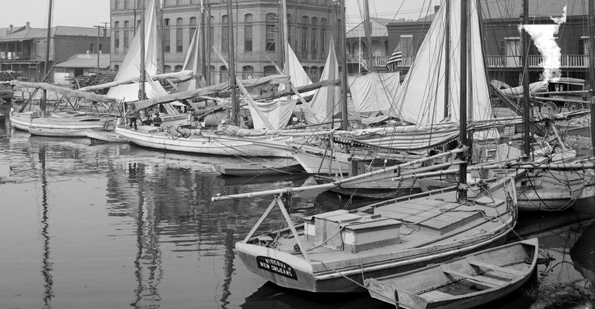Geographer's Space
Lugger Culture
Distinctive sail boats once defined coastal Louisiana’s oyster trade
Published: September 1, 2016
Last Updated: February 4, 2019

Courtesy of the Library of Congress
Oyster Luggers docked at Old Basin Canal in Treme (ca. 1906).
Luggers were small, round-hulled wooden sloops built by hand and used regionally to transport the coastal abundance to the urban marketplace. Their most distinctive characteristic was their “lug rigs,” colorful canvas sails mounted at sharp angle to a boom tethered loosely to a single mast, which gave the vessels phenomenon maneuverability and, to the eyes of visitors, a jaunty and picturesque Old World charm.
One might think the vessel’s name comes from their lugging of heavy cargo, but more likely it derived from the old nautical term for its specialized sail, else the Dutch word “logger,” meaning trawling. There may also be a French etymology. Because oysters comprised their principal cargo, the boats were commonly called oyster luggers, and their leatherneck crews formed a sort of coastal-urban subculture. Up to 200 luggers plied regional waters in the early 1800s, each with crews of three to six men, and the total fleet grew substantially by the early 1900s.
Luggers circulated daily from mid-September through late April from across 80,000 acres of both natural and cultivated oyster reefs in St. Bernard, Plaquemines and Lafourche parishes. When the bivalves were not in season, luggers hauled fish, game, citrus, Creole tomatoes, truck-farm produce — whatever sold.
Where did the lugger come from? Researchers debate the extent to which folk boating designs, much like vernacular architecture, may be traced to external influences versus local invention. The original idea might have arrived courtesy of immigration or interaction with natives. Individuals then adapted the designs to meet local conditions as resources and technology permitted.
Some argue the lugger blueprint came to Louisiana from France, the British Isles or the Low Countries. Others point to Mediterranean and Adriatic influences arriving with Sicilian, Croatian, Greek and Spanish immigrants, all dominant figures in the Louisiana fishing industry.
Perhaps a clue can be gleaned from New Orleans’ sister city of the West, San Francisco, which also boasted a fleet of lugsail-like fishing vessels, called feluccas. Introduced by Italian fishermen, feluccas shared San Francisco Bay with a comparable lugsail watercraft from yet another distant region, the famous junks brought in by Chinese immigrants from Hong Kong’s Victoria Harbor.
One traveler, Catharine Cole, used both “lugger” and “felucca” to describe what she saw along the New Orleans riverfront during her visit in the 1890s. “Just below Canal Street,” Cole wrote, “there is a wharf known as lugger landing, (where) you may see the red-sailed, felucca-like boats from the Barataria, and some day even buy redfish, or shrimp, or white pelican…from the olive-skinned captain.
A second Lugger Landing at the foot of Ursuline Street specialized in the oyster trade, due to its proximity to the French Market. Also known as Picayune Tier, the landing featured a wooden platform hinged to the wharf so that it floated up and down with the river. Luggers would dock perpendicularly to the planked tier and lay down gangplanks for a team of men to unload the sacks to a wooden pavilion.
It might have all looked scenic and charming to outside eyes, but, to insiders, this was business.
It might have all looked scenic and charming to outside eyes, but, to insiders, this was business. There was money to be made and interests to be defended. Who got to unload the luggers presented one point of contention. Members of the Oyster Discharging Association, a union described in an 1894 Picayune article as comprising “Turks, Russians, Austrians, Italians and other nationalities, some…engaged in the unloading of oysters since 1860,” guarded their jobs from off-duty banana unloaders eager for additional work. (“Austrians” connoted Croatians from the Dalmatian Coast, which at the time was part of the Austro-Hungarian Empire.)
Once the harvest was laid out in the pavilion, authorities from the Louisiana Oyster Commission would inspect the oysters for infection and collect taxes due to the state — two additional flashpoints for oystermen, who found themselves at legal loggerheads with regulators constantly in this era.
Yet another controversy involving lugger routes: while lower-coast oysters arrived on the Mississippi, those harvested in the Lake Pontchartrain basin came up either Bayou St. John and the connecting Old Basin Canal in the Fifth Ward or through the New Basin Canal at the edge of the Third Ward. Those rival waterways, the former private and the latter state-owned, battled each other in court for years for the right to be the sole lake oyster port.
Acrimony and litigation also flew among oyster harvesters, luggermen, wholesalers, retailers, restaurateurs and shuckers, each suspecting the other of taking home more than its fair share of the profit, or gaining an unfair advantage from the state.
After disputes were negotiated and the bureaucracy completed, the oysters were iced and sold to wholesalers at $1.25 to $3 per barrel. Some went onto wagons destined for local markets, while others went on rail cars for regional buyers. The best catch went directly to the city’s storied restaurants and saloons, where they commanded upwards of $4 per barrel. “Counter oysters,” eaten raw at the bar, topped the list, and tended to come from the saltier waters of Bayou Cook and Grand Bayou in Barataria Bay. Lower-quality “cooking oysters,” which went straight into the fryer, usually came from the lower-salinity interior waters farther from the Gulf. Competition ensued even at the consumption end of the trade. “The Acme and the Gem, two rival saloons,” reported the Picayune, “entered into a brisk competition” in the late 1870s, “bringing prices down from 30 to 20 cents per dozen. All the rest of the dealers were compelled to follow suit…”

Oyster Luggers docking at Lugger Landing (ca. 1900). Courtesy of the Library of Congress
Like today, New Orleanians craved oysters particularly on Christmas Day, most popularly in the form of oyster dressing. In 1915, despite the harrowing hurricane a few months earlier, 15 vessels deposited at Lugger Landing a record 2,010 barrels of choice counter oysters on Christmas Eve morning.
After the luggermen sold their catch to the wholesalers, they restocked their vessels with supplies needed back in the country and prepared for the long trip home. While reloading, the luggermen would, according to one 1904 account, “loiter idly about, smoking cigarettes or cooking their meals over queer little charcoal furnaces. The [Tier] is a picturesque sight.” In fact, the lugger trade was anything but an idling affair. Time was of the essence and any innovation that sped delivery or maximized profit was adopted without sentimentality.
Three factors ended the lugsail era: the advent of commercially available boat motors starting in the 1910s; the expansion of the riverfront Public Belt Railroad, which needed the lugger landings’ dockspace; and the mounting popularity of gas-powered trucks, which could deliver delicate foods to market faster, better and cheaper. When fitted with refrigeration, truck transportation cut out multiple middlemen, and among them were the luggermen and their loaders.
Picayune Tier became obsolete, the Oyster Discharging Association folded, the Old Basin Canal (now the Lafitte Corridor) was filled in by 1930, and the last stretch of the New Basin Canal was eradicated by 1950 (now a stretch of I-10 and West End Boulevard). Yet despite seemingly endless ecological and economic crises, the regional oyster industry thrives today, though no longer do they sail antique wooden sloops onto Lugger Landing.
Modern oyster vessels in Louisiana are still called luggers, and some of them date from the early 1900s, but few, if any, have sails, much less lugsails. Wrote The Times Picayune in 1925, “The Chinese junk, the Italian felucca, the British barkentine, the American clipper ship or our own Barataria lugger are equally things of loveliness afloat. But…they are doomed (by) the chug-chug of the motorboat…driving them steadily and surely from the seas.”
—–
Richard Campanella, a geographer with the Tulane School of Architecture and a Monroe Fellow with Tulane’s New Orleans Center for the Gulf South, is the author of “Bourbon Street: A History,” “Bienville’s Dilemma,” “Geographies of New Orleans” and other books. He may be reached through richcampanella.com, [email protected], or @nolacampanella on Twitter.
